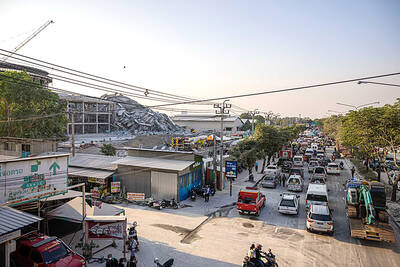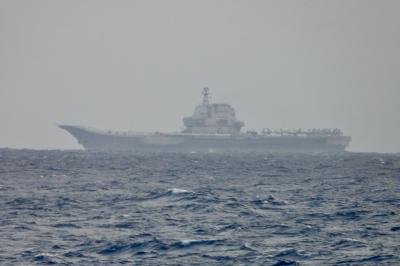Air quality in Lower Manhattan has gradually improved since the early days after the World Trade Center disaster last month, when a gritty residue of combustion and dust hung over parts of the city like a shroud. But at certain times, under certain conditions -- usually for brief periods -- the bad air still returns.
Most health experts are not terribly alarmed about the effect of these episodes on a generally healthy population. Still, many people remain concerned about the smells and dust that can make eyes and throats burn, and anxious that conflicting information has left them at risk.
The health experts say that because the spikes do not last long and often occur in the middle of the night when few residents or office workers are on the streets, most people need not worry. Workers at the cleanup site itself, of course, are still advised to wear respiratory protection.

PHOTO: NY TIMES
But the deeper questions that scientists and physicians are posing -- where exactly the fouled air is coming from and what fosters its resurgence, often just before dawn -- constitute something of a downtown mystery.
The prime suspects include, logically enough, the smoke from the still-smoldering ruins, but also the many diesel vehicles operating in and around the site. The peculiarities of the weather add yet another wrinkle of complexity, researchers say.
"This is an unusual case," said George Thurston, an associate professor of environmental medicine at New York University School of Medicine, which has set up its own air-monitoring device close to "Ground Zero" and alongside other monitors from the federal government and other private institutions.
The monitors tracking pollution around the World Trade Center site are not able to distinguish how much of the so-called pollution particulates are being generated by the fire in the depths of the ruins, which cleanup crews have not yet reached, and the heavy diesel machinery at the surface, much of which operates around the clock.
But there are hints and clues. Sulfates taken from the air samples, for instance, are probably from diesel combustion, while other components, like chlorine, could at least in part be coming from burning plastics somewhere down in the rubble, Thurston said.
The fire, which has burned more or less constantly since Sept. 11, is fed by the huge compilation of buried office material and the added oxygen that becomes available when some of the ruins are removed.
Regardless of the mix, he and other experts say that atmospheric conditions in the fall, which tend to keep a lid on air circulation in the city, could make night air pollution worse, or at least more frequent, in coming weeks. One of the highest one-hour readings in recent weeks for fine particulate matter in the Trade Center area was recorded at 2am last Friday, for example, by a monitor at Pace University.
Thurston, in particular, has argued that watching the weather forecast should become a part of the cleanup operation, and that administrators should consider suspending work at times when unfavorable air patterns emerge. Other air-quality groups, like the American Lung Association, have argued that the cleanup project itself should be made cleaner through technologies and fuels that would reduce diesel emissions.
"Until it runs out of fuel or until you can get to it to put water on it, it will continue to burn," said Arthur Cote, senior vice president and chief engineer with the National Fire Protection Association.
Almost everything inside the towers, from documents to office furniture, can serve as fuel for the fires, Cote said. And as debris is moved and air pockets shift, fresh oxygen can cause hot spots to flare up.
The fire department has equipment at the site to deal with flare-ups, said spokesman Dave Billig.
"They're ready to go if the need arises," he said.
If it was just a question of clearing debris, those toiling on the site could probably move the material faster and put out the fires sooner, Cote said.
Officials at the Federal Environmental Protection Agency say the issues of particulate pollution and Lower Manhattan weather patterns are not that simple. They say that federal health standards for fine particulates have never been exceeded at any of the agency's monitors for any period averaged over 24 hours since Sept. 11, and that no health standards have been established for short-term surges because the harmful health effects of short exposures have not been proven.
Some studies, though, indicate that some people with heart disease and other problems could be affected by even brief pollution spikes.
However, officials of two of the major construction firms working on the cleanup shrugged off the coming winter. Plans are being laid for large amounts of salt to keep the site's roads from freezing.
Heavy machinery is now doing about 75 percent of the clearing of tangled steel and concrete.
By most estimates, a quarter of the debris has been removed.
Although the forecast calls for a colder winter than last year, when 71cm of snow fell in New York, the construction leaders still stand by earlier estimates that the cleanup will take a year.

AIR SUPPORT: The Ministry of National Defense thanked the US for the delivery, adding that it was an indicator of the White House’s commitment to the Taiwan Relations Act Deputy Minister of National Defense Po Horng-huei (柏鴻輝) and Representative to the US Alexander Yui on Friday attended a delivery ceremony for the first of Taiwan’s long-awaited 66 F-16C/D Block 70 jets at a Lockheed Martin Corp factory in Greenville, South Carolina. “We are so proud to be the global home of the F-16 and to support Taiwan’s air defense capabilities,” US Representative William Timmons wrote on X, alongside a photograph of Taiwanese and US officials at the event. The F-16C/D Block 70 jets Taiwan ordered have the same capabilities as aircraft that had been upgraded to F-16Vs. The batch of Lockheed Martin

GRIDLOCK: The National Fire Agency’s Special Search and Rescue team is on standby to travel to the countries to help out with the rescue effort A powerful earthquake rocked Myanmar and neighboring Thailand yesterday, killing at least three people in Bangkok and burying dozens when a high-rise building under construction collapsed. Footage shared on social media from Myanmar’s second-largest city showed widespread destruction, raising fears that many were trapped under the rubble or killed. The magnitude 7.7 earthquake, with an epicenter near Mandalay in Myanmar, struck at midday and was followed by a strong magnitude 6.4 aftershock. The extent of death, injury and destruction — especially in Myanmar, which is embroiled in a civil war and where information is tightly controlled at the best of times —

China's military today said it began joint army, navy and rocket force exercises around Taiwan to "serve as a stern warning and powerful deterrent against Taiwanese independence," calling President William Lai (賴清德) a "parasite." The exercises come after Lai called Beijing a "foreign hostile force" last month. More than 10 Chinese military ships approached close to Taiwan's 24 nautical mile (44.4km) contiguous zone this morning and Taiwan sent its own warships to respond, two senior Taiwanese officials said. Taiwan has not yet detected any live fire by the Chinese military so far, one of the officials said. The drills took place after US Secretary

THUGGISH BEHAVIOR: Encouraging people to report independence supporters is another intimidation tactic that threatens cross-strait peace, the state department said China setting up an online system for reporting “Taiwanese independence” advocates is an “irresponsible and reprehensible” act, a US government spokesperson said on Friday. “China’s call for private individuals to report on alleged ‘persecution or suppression’ by supposed ‘Taiwan independence henchmen and accomplices’ is irresponsible and reprehensible,” an unnamed US Department of State spokesperson told the Central News Agency in an e-mail. The move is part of Beijing’s “intimidation campaign” against Taiwan and its supporters, and is “threatening free speech around the world, destabilizing the Indo-Pacific region, and deliberately eroding the cross-strait status quo,” the spokesperson said. The Chinese Communist Party’s “threats